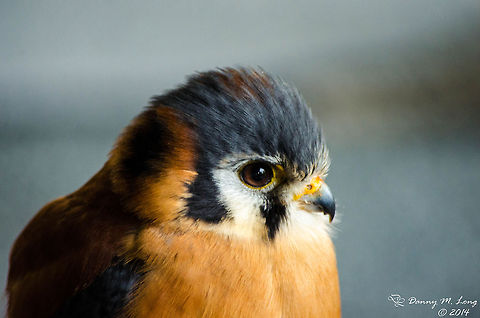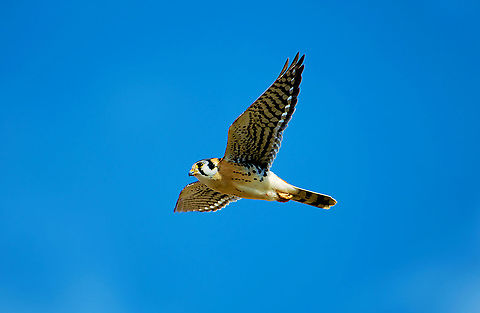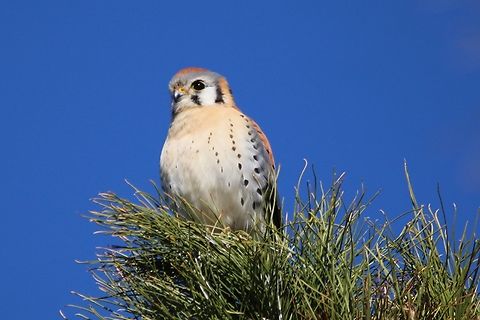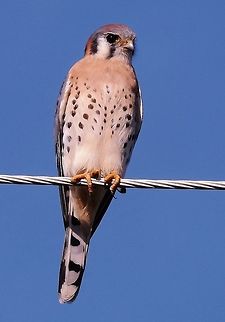
Appearance
The American Kestrel is the smallest falcon in North America and, under traditional classification, is the smallest raptor in America. The American Kestrel is sexually dimorphic, although there is some overlap in plumage coloration between the sexes. The bird ranges from 12 to 27 cm in length with a wingspan of 50–61 cm. The female kestrel is larger than the male. The male weighs 80–105 g, as opposed to the female which weighs 100–120 g. In standard measurements, the wing bone is 16–21 cm long, the tail is 11–15 cm and the tarsus is 3.2–4 cm.In contrast to many other raptor species, the sexes differ more in plumage than in size. Males have blue-grey wings with black spots and white undersides with black barring. The back is rufous, with barring on the lower half. The belly and flanks are white with black spotting. The tail is also rufous, with a white or rufous tip and a black subterminal band. The back and wings of the female American Kestrel are rufous with dark brown barring. The undersides of the females are creamy to buff with heavy brown streaking. The tail is noticeably different from the male's, being rufous in color with numerous narrow dark black bars. Juveniles exhibit coloration patterns similar to the adults'. In both sexes, the head is white with a bluish-grey top. There are also two narrow, vertical black facial markings on each side of the head, while other falcons have one. Two black spots can be found on each side of the white or orangish nape. The function of these spots is debated, but the most commonly accepted theory is that they act as "false eyes", and help to protect the bird from potential attackers. The wings are moderately long, fairly narrow, and taper to a point.

Status
The American Kestrel is likely the most abundant falcon in North America, although its total population is difficult to quantify, as local populations can change quickly due to resource availability. Count data from the USGS Breeding Bird Survey indicate that the North American breeding population is experiencing long-term and gradual but sustained declines, with some regions, such as New England and coastal California, exhibiting more rapid declines. Count data from raptor migration corridors also indicate regional population declines and largely corroborate BBS data. The North American population has been estimated at 1.2 million pairs, with the Central and South American populations being as large. A smaller estimate is 236,000 birds wintering in North America. A population increase occurred in the 18th and 19th centuries, probably due to deforestation for agriculture. The resulting pastures provided an ideal habitat for kestrels.The southeastern U.S. subspecies has declined 82% since 1940 due to a decrease in nest site availability. This decline is a result of Longleaf Pines being cleared from agricultural fields. Despite this, the American Kestrel is classed as Least Concern on the IUCN Red List.
The Peregrine Fund, a leading non-profit organization advancing research and conservation of birds of prey worldwide, launched the American Kestrel Partnership in 2012. The American Kestrel Partnership developed and maintains a web-based network for citizen and professional scientists to enter, manage, and consolidate data from kestrel nestbox monitoring programs in the Western Hemisphere. The database is being used by researchers to model and understand relationships between kestrel nesting parameters and environmental factors, such as land use, landscape composition and configuration, climate conditions, and point sources of environmental toxins. The American Kestrel Partnership's website, with support from the Cornell Laboratory of Ornithology, features two live, streaming video feeds from a kestrel nestbox and breeding pair on The Peregrine Fund's campus in Boise, Idaho.

Behavior
The American Kestrel hunts by hovering in the air with rapid wing beats or perching and scanning the ground for prey. Its diet typically consists of grasshoppers, lizards, mice, and small birds. It nests in cavities in trees, cliffs, buildings, and other structures. The female lays three to seven eggs, which both sexes help to incubate. It is a common bird to be used in falconry, especially by beginners.
Habitat
American Kestrels are found in a wide variety of habitats, including grasslands, meadows, deserts, and other open to semiopen regions. They can also be found in both urban and suburban areas. A kestrel's habitat must include perches, open space for hunting, and cavities for nesting. The American Kestrel is able to live in very diverse conditions, ranging from above the Arctic Circle, to the tropics of Central America, to elevations of over 4,500 m in the Andes Mountains. The bird is distributed from northern Canada and Alaska to the southernmost tip of South America, Tierra del Fuego. It is the only kestrel found in the Americas. It has occurred as a vagrant in the UK, Denmark, Malta and the Azores.American Kestrels in Canada and the northern United States typically migrate south in the winter, sometimes going as far as Central America and the Caribbean. Birds that breed south of about 35° north latitude are usually year-round residents. Migration also depends on local weather conditions. Wintering kestrels' choice of habitat varies by sex. Females are found in open areas more often than males during the non-breeding season. A common explanation for this behavior is that the larger females arrive at the preferred habitat first and exclude males from their territory.
The American Kestrel is not long-lived, with a lifespan of

Reproduction
American Kestrels are sexually mature by their first spring. In migratory populations, the males arrive at the breeding ground before females, then the female selects a mate. Pair bonds are strong, often permanent. Pairs usually use previous nesting sites in consecutive years. This gives birds an advantage over younger or invading individuals, as they would already be familiar with the hunting grounds, neighbors, predators, and other features of the site. Males perform elaborate dive displays to advertise their territory and attract a mate. These displays consist of several climbs and dives, with three or four "klee" calls at their peaks. Females are promiscuous for about one to two weeks after their arrival at the nesting site. This is thought to stimulate ovulation. Food transfers from the male to the female occur from about four to five weeks prior to egg laying to one to two weeks after.American Kestrels are cavity nesters, but they are able to adapt to a wide variety of nesting situations. They generally prefer natural cavities with closed tops and tight fitting entrances, as to provide for maximum protection of the eggs and young. Kestrels occasionally nest in holes created by large woodpeckers, or use the abandoned nests of other birds, such as Red-tailed Hawks, Merlins, and crows. They have been recorded nesting on cliff ledges and building tops, as well as in abandoned cavities in cactuses. American Kestrels also commonly utilize nesting boxes.
Three to seven eggs are laid approximately 24–72 hours apart. The average egg size is 32 mm × 29 mm, 10% larger than average for birds of its body size. The eggs are white to cream in color with brown or grey splotching. Incubation usually lasts 30 days and is mainly the responsibility of the female, although the male incubates 15–20% of the time. Eggs which are lost are typically replaced in 11–12 days. Hatching takes place over three to four days. Hatchlings are altricial, and are only able to sit up after five days. They grow very quickly, reaching an adult weight after 16–17 days. After 28–31 days, their wings develop and they are able to leave the nest.
The young adults kestrels may breed from a year old, and the species has a ten year life expectancy.

Food
American Kestrels feed largely on small animals such as grasshoppers, dragonflies, lizards, mice, and voles. They will occasionally eat small birds. The kestrel has also been reported to have killed snakes, bats, and squirrels. The kestrel is able to maintain high population densities, at least in part because of the broad scope of its diet. The American Kestrel's primary mode of hunting is by perching and waiting for prey to come near. The bird is characteristically seen along roadsides or fields perched on objects such as trees, overhead power lines, or fence posts. It also hunts by kiting, hovering in the air with rapid wing beats and scanning the ground for prey. Other hunting techniques include low flight over fields, or chasing insects in the air.Prey is almost always caught on the ground. Before striking, the kestrel characteristically bobs its head and tail, then makes a direct flight toward the prey to grab it in its talons. During the breeding season, the bird will carry large prey back to its mate or young. One study found that an American Kestrel pair "foraged in ways that minimized the costs of energy acquisition in its particular situation". For example, if the success rate for catching prey decreases significantly in a particular area, the bird will move to a different area.
References:
Some text fragments are auto parsed from Wikipedia.